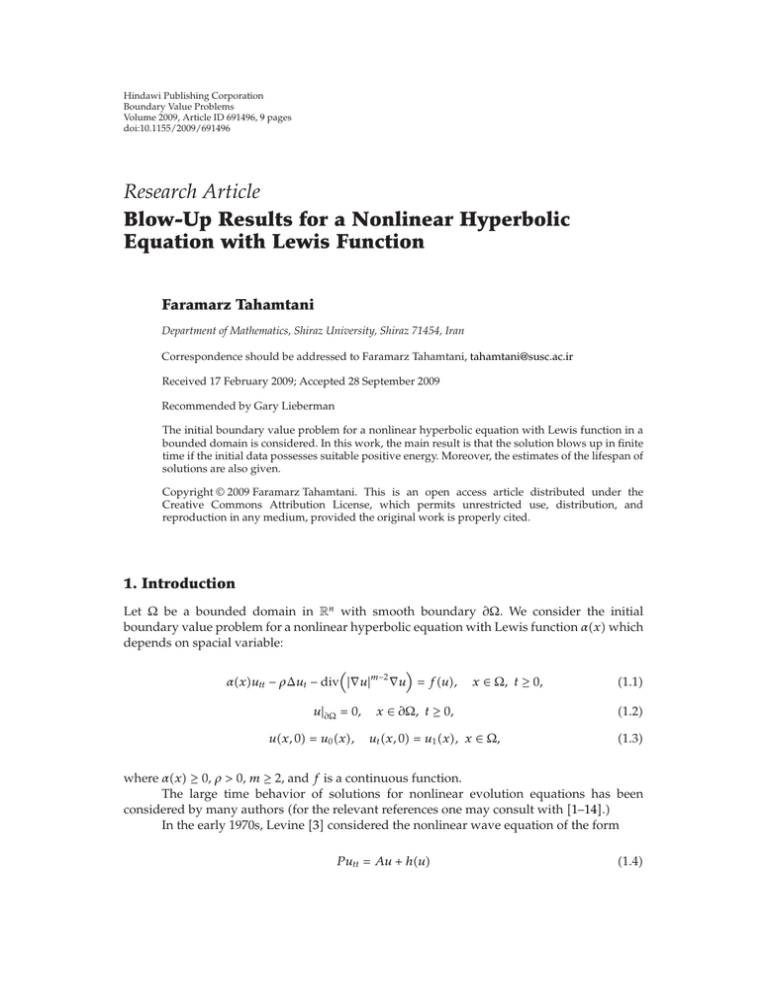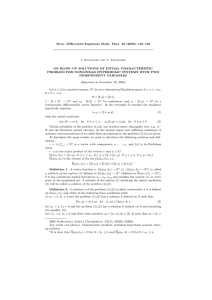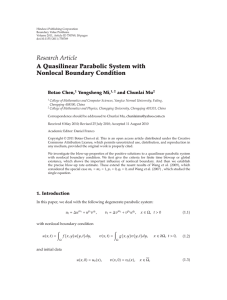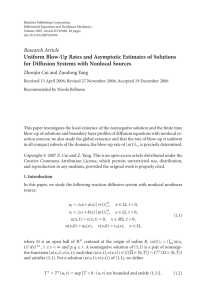Document 10841106
advertisement

Hindawi Publishing Corporation Boundary Value Problems Volume 2009, Article ID 691496, 9 pages doi:10.1155/2009/691496 Research Article Blow-Up Results for a Nonlinear Hyperbolic Equation with Lewis Function Faramarz Tahamtani Department of Mathematics, Shiraz University, Shiraz 71454, Iran Correspondence should be addressed to Faramarz Tahamtani, tahamtani@susc.ac.ir Received 17 February 2009; Accepted 28 September 2009 Recommended by Gary Lieberman The initial boundary value problem for a nonlinear hyperbolic equation with Lewis function in a bounded domain is considered. In this work, the main result is that the solution blows up in finite time if the initial data possesses suitable positive energy. Moreover, the estimates of the lifespan of solutions are also given. Copyright q 2009 Faramarz Tahamtani. This is an open access article distributed under the Creative Commons Attribution License, which permits unrestricted use, distribution, and reproduction in any medium, provided the original work is properly cited. 1. Introduction Let Ω be a bounded domain in Rn with smooth boundary ∂Ω. We consider the initial boundary value problem for a nonlinear hyperbolic equation with Lewis function αx which depends on spacial variable: αxutt − ρΔut − div |∇u|m−2 ∇u fu, u|∂Ω 0, ux, 0 u0 x, x ∈ Ω, t ≥ 0, x ∈ ∂Ω, t ≥ 0, ut x, 0 u1 x, x ∈ Ω, 1.1 1.2 1.3 where αx ≥ 0, ρ > 0, m ≥ 2, and f is a continuous function. The large time behavior of solutions for nonlinear evolution equations has been considered by many authors for the relevant references one may consult with 1–14. In the early 1970s, Levine 3 considered the nonlinear wave equation of the form P utt Au hu 1.4 2 Boundary Value Problems in a Hilbert space where P are A are positive linear operators defined on some dense subspace of the Hilbert space and h is a gradient operator. He introduced the concavity method and showed that solutions with negative initial energy blow up in finite time. This method was later improved by Kalantarov and Ladyzheskaya 4 to accommodate more general cases. Very recently, Zhou 10 considered the initial boundary value problem for a quasilinear parabolic equation with a generalized Lewis function which depends on both spacial variable and time. He obtained the blowup of solutions with positive initial energy. In the case with zero initial energy Zhou 11 obtained a blow-up result for a nonlinear wave equation in Rn . A global nonexistence result for a semilinear Petrovsky equation was given in 14. In this work, we consider blow-up results in finite time for solutions of problem 1.11.3 if the initial datas possesses suitable positive energy and obtain a precise estimate for the lifespan of solutions. The proof of our technique is similar to the one in 10. Moreover, we also show the blowup of solution in finite time with nonpositive initial energy. Throughout this paper · X denotes the usual norm of LX Ω. The source term fu in 1.1 with the primitive Fu u fξdξ 1.5 c0 > 0, p > m ≥ 2, 1.6 0 satisfies fu ≤ c0 |u|p−1 , β1 mFu β2 m|∇u|m−1 ∇ut ≤ pFu < ufu, β1 > 1, β2 > 0. 1.7 Let B be the best constant of Sobolev embedding inequality up ≤ B∇um 1.8 from W01,m Ω to LP Ω. We need the following lemma in 4, Lemma 2.1. Lemma 1.1. Suppose that a positive, twice differentiable function Ψt satisfies for t ≥ 0 the inequality Ψ Ψ − 1 σΨ ≥ 0, 2 σ > 0. 1.9 If Ψ0 > 0, Ψ 0 > 0, then Ψ −→ ∞ as t −→ t1 < t2 Ψ0 . σΨ 0 1.10 Boundary Value Problems 3 2. Blow-Up Results We set λ0 c0 Bm −1/p−m , E0 p−m c0 Bp −m/p−m . pm 2.1 The corresponding energy to the problem 1.1-1.3 is given by 1 Et m 1 |∇u| dx 2 Ω m Ω αxu2t dx − Ω Fudx, 2.2 and one can find that Et ≤ E0 easily from E t −ρ∇u22 ≤ 0, 2.3 whence Et E0 − ρ t 0 ∇uτ 22 dτ. 2.4 We note that from 1.6 and 1.7, we have Et ≥ 1 c0 p ∇um up , m− m p t ≥ 0, 2.5 and by Sobolev inequality 1.8, Et ≤ Gup , t ≥ 0, where Gλ mBm −1 λm − c0 p−1 λp . 2.6 Note that Gλ has the maximum value E0 at λ0 which are given in 2.1. Adapting the idea of Zhou 10, we have the following lemma. Lemma 2.1. Suppose that ux, 0p > λ0 and E0 ≤ E0 . Then p 1/m ∇ux, tm > c0 λ0 ux, tp > λ0 , 2.7 for all t ≥ 0. Theorem 2.2. For αx ∈ L∞ Ω, suppose that u0 ∈ W01,m Ω and u1 ∈ L2 Ω satisfy μx : Ω αxu0 u1 dx > 0. 2.8 4 Boundary Value Problems If 0 < E0 ≤ E0 , then the global solution of the problem 1.1–1.3 blows up in finite time and the lifespan 2 ∇u0 22 − p − 2 μx . T< 2 p − 2 E0 − E0 2.9 Proof. To prove the theorem, it suffices to show that the function t 2 At αxu ρ ∇u22 dτ ρT0 − t∇u0 22 γt t0 2 2 2.10 0 satisfies the hypotheses of the Lemma 1.1, where T0 > t, t0 > 0 and γ > 0 to be determined later. To achieve this goal let us observe t t d ∇u22 dτ 2 ∇u∇uτ dxdτ dτ 0 Ω 0 ∇u22 − 2.11 ∇u0 22 . Hence, t ∇u∇uτ dxdτ ∇u0 22 . ∇u22 2 Ω 0 2.12 Let us compute the derivatives A t and A t. Thus one has A t 2 αxuut dx ρ∇u22 − ρ∇u0 22 2γt t0 Ω t 2 αxuut dx 2ρ ∇u∇uτ dxdτ 2γt t0 , Ω 0 2.13 Ω and 2 m A t 2 − 2∇u 2 ufudx 2γ αxu t m Ω 2 2 m ≥ 2 αxut − 2∇um 2p Fudx 2γ Ω 2 2 p − 1 ∇um ≥ p2 αxu 2 t m − 2pEt 2γ m 2 t 2 p 2 − 1 ∇um ≥ p 2 αxut ρ ∇uτ 2 dτ 2 m − 2pE0 2γ m 2 0 2.14 Boundary Value Problems 5 for all t ≥ 0. In the above assumption 1.7, the definition of energy functionals 2.2 and 2.4 has been used. Then, due to 2.1 and 2.7 and taking γ 2E0 − E0, t 2 2 A t ≥ p 2 αxut ρ ∇uτ 2 dτ γ . 2 2.15 0 Hence A t ≥ 0 for all t ≥ 0 and by assumption 2.8 we have A 0 2 μx γt0 > 0. 2.16 Therefore A t ≥ 0 for all t ≥ 0 and by the construction of At, it is clearly that t 2 ρ ∇u2 dτ γt t0 2 , At ≥ αxu 2 2 2.17 0 whence, A0 > 0. Thus for all a, b ∈ R2 , from 2.13, 2.15, and 2.17 we obtain t 2 −1 2 2 2 2 a At abA t p 2 b A t ≥ a αxu ρ ∇u2 dτ γt t0 2 2 0 2ab Ω αxuut dx ρ t 0 Ω ∇u∇uτ dxdτ γt t0 t 2 2 b αxut ρ ∇uτ 2 dτ γ 2 2 0 2 αxau but ρ t 0 2 a∇u b∇uτ 22 dτ γat t0 b2 ≥ 0, 2.18 which implies A t 2 − 4 AtA t ≤ 0. p2 2.19 Then using Lemma 1.1, one obtain that At → ∞ as 2 2 αxu0 T0 ∇u0 22 γt20 2 4A0 . t −→ p − 2 A 0 p − 2 μx γt0 2.20 6 Boundary Value Problems Now, we are in a position to choose suitable t0 and T0 . Let t0 be a number that depends on p, E0 − E0, ∇u0 L2 Ω , and μx as 2∇u0 22 − p − 2 μx . t0 > p−2 γ 2.21 To choose T0 , we may fix t0 as 2 2 αxu0 2 2T0 ∇u0 22 2γt20 T0 p − 2 μx γt0 2 2 αxu0 2 γt20 . p − 2 μx γt0 − 2∇u0 22 2.22 Thus, for t ≥ t0 the lifespan T is estimated by 2 2 αxu0 2 2γt2 T< p − 2 μx γt − 2∇u0 22 2∇u0 22 − p − 2 μx , < 2 p − 2 E0 − E0 2.23 which completes the proof. Theorem 2.3. Assume that αx ∈ L∞ Ω and the following conditions are valid: u0 ∈ W01,m , u1 ∈ L2 Ω, E0 ≤ 0. 2.24 Then the corresponding solution to 1.1–1.3 blows up in finite time. Proof. Let t 2 Bt αxu ρ ∇u22 dτ, 2 0 2.25 Boundary Value Problems 7 then B t 2 αxuut dx ρ∇u22 , 2.26 Ω 2 B t 2 αxu 2 αxuu dx 2ρ ∇u∇ut dx t tt Ω 2 Ω 2 m 2 αxu − 2∇u 2 ufudx t m Ω 2 2 − 2∇um > 2 αxu 2β m Fudx 2β m |∇u|m−1 ∇ut dx t 1 2 m Ω 2 Ω 2.27 2 2 β1 − 1 ∇um 2β2 d ∇um − 2β1 mE0 > 2 β1 1 αxu t m m dt 2 d ∇um > 2 β1 − 1 ∇um m 2β2 m − 2β1 mE0, dt t > 0, where the left-hand side of assumption 1.7 and the energy functional 2.2 have been used. Taking the inequality 2.27 and integrating this, we obtain B t > 2 β1 − 1 t 0 m ∇um m dτ 2β2 ∇um − 2β1 mE0t B 0, t > 0. 2.28 By using Poincare-Friedrich’s inequality u22 ≤ λ1 ∇u22 , 2.29 and Holder’s inequality −m/2 |Ω|1−m/2 ∇um m ≥ λ1 M t 0 ∇um m dτ ≥t 1−m/2 Ω t 0 αxu2 dx m/2 , 2.30 m/2 ∇u22 dτ , 2.31 8 Boundary Value Problems where M maxΩ |αx|. Using 2.30 and 2.31, we find from 2.28 that B t ≥ 2β2 λ1 M−m/2 |Ω|1−m/2 2 β1 − 1 t1−m/2 t 0 Ω αxu2 dx m/2 t 0 − 2β1 mE0t B 0 ∇u22 dτ ≥ 2β2 λ1 M−m/2 |Ω|1−m/2 t1−m/2 2 β1 − 1 t1−m/2 m/2 Ω αxu2 dx 2.32 m/2 m/2 − 2β1 mE0t B 0, ∇u22 dτ t > 1. Since −2β1 mE0t B 0 → ∞ as t → ∞ so, there must be a t1 > 1 such that −2β1 mE0t B 0 ≥ 0 as t > t1 . 2.33 a1 a2 r < 2r−1 ar1 ar2 , 2.34 By inequality r>1 and by virtue of 2.33 and using 2.32, we get B t ≥ Ct1−m/2 Btm/2 , 2.35 C min 22−m/2 β1 − 1 , 22−m/2 β2 λ1 M−m/2 |Ω|1−m/2 . 2.36 where Therefore, there exits a positive constant T ⎧ ⎨C expt1 , m 2, ⎩Ct4−m/2−m , 1 m > 2, 2.37 such that Bt −→ ∞ This completes the proof. as t −→ T − . 2.38 Boundary Value Problems 9 References 1 D. D. Áng and A. P. N. Dinh, “On the strongly damped wave equation: utt − Δu − Δut fu 0,” SIAM Journal on Mathematical Analysis, vol. 19, no. 6, pp. 1409–1418, 1988. 2 K. Nishihara, “Asymptotic behavior of solutions of quasilinear hyperbolic equations with linear damping,” Journal of Differential Equations, vol. 137, no. 2, pp. 384–395, 1997. 3 H. A. Levine, “Instability and nonexistence of global solutions to nonlinear wave equations of the form P utt −Au Fu,” Transactions of the American Mathematical Society, vol. 192, pp. 1–21, 1974. 4 V. K. Kalantarov and O. A. Ladyzhenskaya, “The occurrence of collapase for quasi-linear equations of parabolic and hyperbolic type,” Journal of Soviet Mathematics, vol. 10, pp. 53–70, 1978. 5 M. Can, S. R. Park, and F. Aliyev, “Nonexistence of global solutions of some quasilinear hyperbolic equations,” Journal of Mathematical Analysis and Applications, vol. 213, no. 2, pp. 540–553, 1997. 6 K. Ono, “Global existence, asymptotic behaviour, and global non-existence of solutions for damped non-linear wave equations of Kirchhoff type in the whole space,” Mathematical Methods in the Applied Sciences, vol. 23, no. 6, pp. 535–560, 2000. 7 Z. Tan, “The reaction-diffusion equation with Lewis function and critical Sobolev exponent,” Journal of Mathematical Analysis and Applications, vol. 272, no. 2, pp. 480–495, 2002. 8 Y. Zhijian, “Global existence, asymptotic behavior and blowup of solutions for a class of nonlinear wave equations with dissipative term,” Journal of Differential Equations, vol. 187, no. 2, pp. 520–540, 2003. 9 N. Polat, D. Kaya, and H. I. Tutalar, “Blow-up of solutions for a class of nonlinear wave equations,” in Proceedings of the International Conference on Dynamic Systems and Applications, pp. 572–576, July 2004. 10 Y. Zhou, “Global nonexistence for a quasilinear evolution equation with a generalized Lewis function,” Journal for Analysis and Its Applications, vol. 24, no. 1, pp. 179–187, 2005. 11 Y. Zhou, “A blow-up result for a nonlinear wave equation with damping and vanishing initial energy in Rn ,” Applied Mathematics Letters, vol. 18, no. 3, pp. 281–286, 2005. 12 S.-T. Wu and L.-Y. Tsai, “Blow-up of solutions for evolution equations with nonlinear damping,” Applied Mathematics E-Notes, vol. 6, pp. 58–65, 2006. 13 S. A. Messaoudi and B. S. Houari, “A blow-up result for a higher-order nonlinear Kirchhoff-type hyperbolic equation,” Applied Mathematics Letters, vol. 20, no. 8, pp. 866–871, 2007. 14 W. Chen and Y. Zhou, “Global nonexistence for a semilinear Petrovsky equation,” Nonlinear Analysis: Theory, Methods & Applications, vol. 70, no. 9, pp. 3203–3208, 2009.









